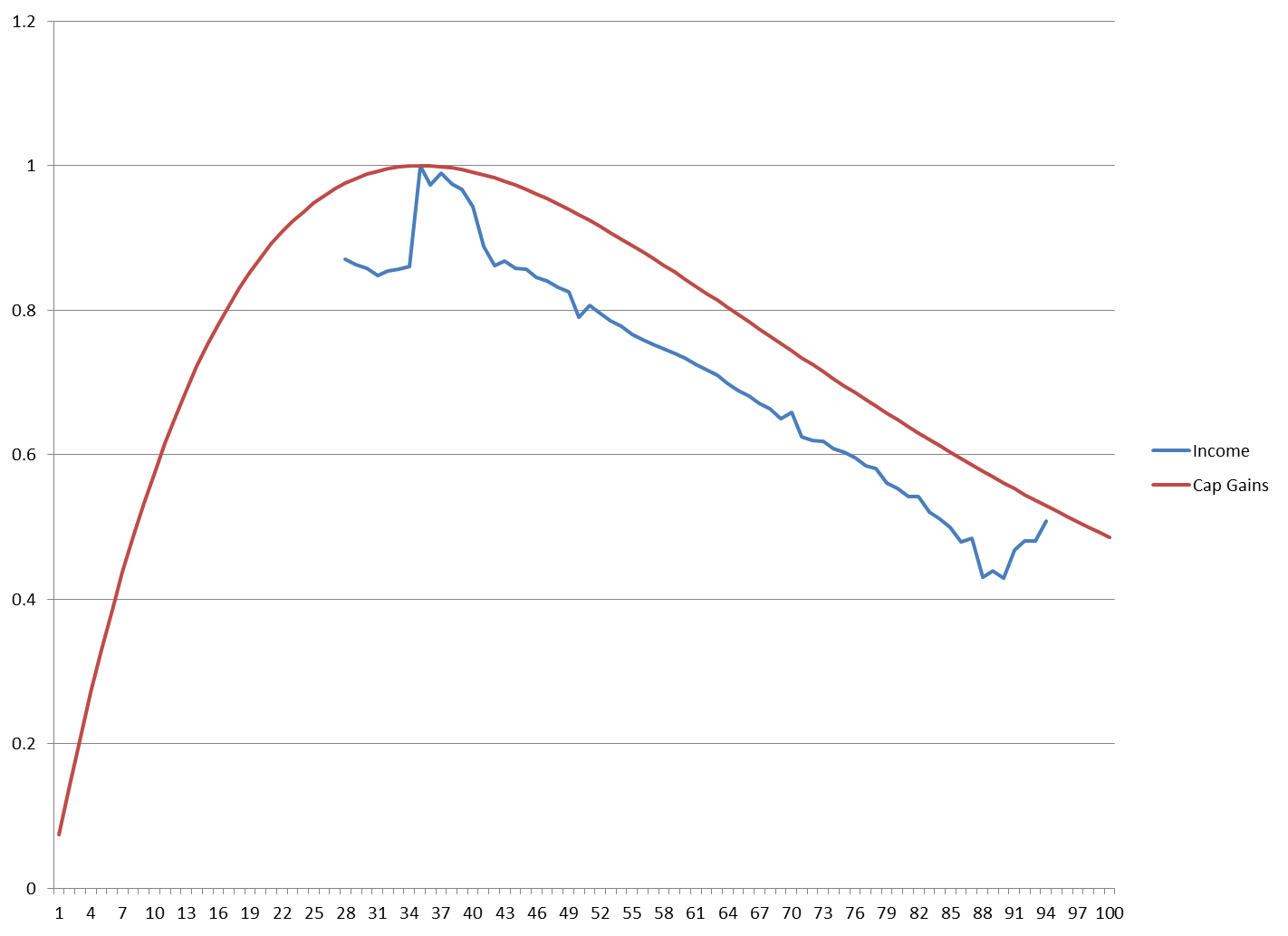-
The Behavior Curve
Good questions! I was wondering the same thing.
Last night I worked on the data a bit more.
The 35% maximum point was a puzzle because it was the same as the maximum point on the idealized Capital Gains revenue curve I did in November.
The problem is that the idealized curve assumed no investor behavior change. That is, it assumed that you would make the same investments regardless of whether the capital gains rate were 1% or 100%. In other words, you'd still invest even if the government took ALL the money!
Ridiculous.
And yet...
...after I did the math it was correct.
So, a little blog preview.

The graph above measures the percentage of capital gains taxes collected by the government from 1 to 100%, assuming there was NO CHANGE AT ALL to investor behavior. (The red line is the no behavior change curve; the blue line are actual per capita Federal Income Tax revenues at each percentage rate between 28 and 94%).
The time frame is agnostic. I took 74 different time ranges (from 1 year, to 2 year average, all the way through 74 year average) and used them all.
To put them on the same scale I took each percentage rate's actual returns divided by the maximum potential returns reached at 35%. So, 35% = 1.
The Obama rate change from 35% to 43.80%, then, should collect approximately 86.78% of the revenue per capita that was previously collected -- on average (some years will be more and some less).
Art Laffer (and most Conservatives) argue that taxpayer behavior changes at different rates, and that there is a disincentive to work that will drive down taxes.
They're wrong. Historical income tax rates versus per capita revenue in fact follow the "no behavior change" curve almost perfectly.
The revenue DOES go down, however -- and this is where Liberals get it wrong. It's not that taxpayer BEHAVIOR changes, but that aggregate behavior changes as people simply run out of money. The government doesn't tax static income, but rather the churning of layers of income as economic activity progresses. So, your corporation gets taxed, but they pay you with what's left, and you pay the car dealer with what's left, and the grocery store... and THEY pay still other people with what's left until everyone runs out of spending money.
When you raise tax rates past 35%, people run out of money faster and economic activity has less iterations. You might still buy a car and groceries, but your grocery clerk may not be able to buy a car, so there is one less item to tax.
Total income for the country goes down, and therefore for the government.
In other words, the Liberals are right about the individual, but wrong about the revenue. Behavior does not deliberately change -- but the revenue goes down anyway.
In any case, I'll expand on this on my next blog entry, and probably give the raw data I used as well.
There are no historical data sets I could find for Federal income tax rates below 28% or above 94%, so the best I can do is to use my idealized Capital Gains curve as an analog for the slope.
PS -- you'll note that the 100% tax rate does NOT fall to 0% revenues, as Art Laffer speculated. And in fact there is good history for this. In the Soviet Union the tax rate was theoretically 100% (before theoretical redistribution), but the slope only terminates at 48.54% of the potential revenues that would have been raised at 35% (ie if per capital revenues would be 10,000 dollars at 35%, they would be approximately 4,854 dollars at a 100% tax rate, instead of the 0 dollars Art Laffer suggested.
Last edited by Timothy Clontz; 01-10-2013 at 12:31 PM.
Reason: added PS about Russia
 Posting Permissions
Posting Permissions
- You may not post new threads
- You may not post replies
- You may not post attachments
- You may not edit your posts
Forum Rules



 Reply With Quote
Reply With Quote